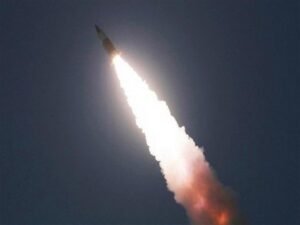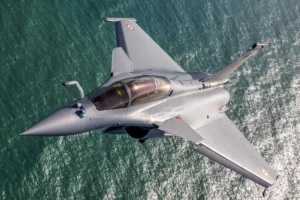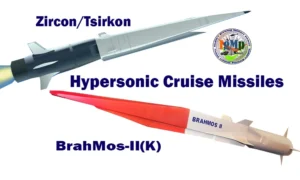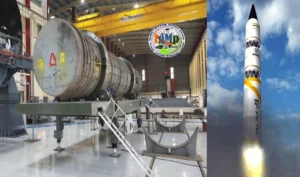 |
| Artist’s impression of the TEDBF fighter plane operating from INS Vikrant |
India’s indigenously developed aircraft carrier INS Vikrant, a crucial part of New Delhi’s ability to counter China’s expanding naval reach, is scheduled to be put into service, soon.
Initially, INS Vikrant could be outfitted with the existing MiG-29K Fulcrum aircraft. However, as widely reported, the Indian Navy is evaluating Dassault Rafale-M and Boeing’s F-18 Super Hornet that can operate from INS Vikrant.
However, another candidate that might assist India’s future aircraft carrier is the HAL Twin Engine Deck Based Fighter (TEDBF).
This plane is still in the research and development stage. Under the Ministry of Defense, the Aeronautical Development Agency (ADA) has designed the aircraft.
Naturally, the TEDBF could be viewed as the successor of the Naval variant of the indigenous Tejas jet. The Tejas is a light combat aircraft with a single-engine. But the Indian Navy has concluded that it needs a twin-engine plane to take over the role of the MiG-29K.
With improved landing gear, the HAL Twin Engine Deck Based Fighter (TEDBF) is specifically designed for the Indian Navy. It also has wings that can be folded and modified for catapult launch.
Meanwhile, a land-based Twin Engine Deck-based fighter jet called Omni Role Combat Aircraft, or ORCA, is also under development.
 |
| Aero India 2021: Indian TEDBF naval fighter showcased by HAL |
The ORCA, also known as the ‘Super Tejas’, will be comparable to the Rafale fighter jet. Experts often touted it as 40% better and 30% cheaper than Rafale.
Along with other MRCA fighters, possibly Rafale-M, TEDBF will be used as the primary fighter in INS Vikrant and INS Vishal. The INS Vishal is India’s third planned aircraft carrier.
More importantly, unlike its predecessor, the Tejas Mk2, the TEDBF won’t become obsolete owing to its high composite usage of about 90%, lower price, and higher reliability. The TEDBF fighter jet will replace the Indian Navy’s MiG-29K fighter aircraft.
The TEDBF fighter is a twin-engine canard derivative of the Tejas fighter jet that is carrier-based and multi-role. HAL and the Aeronautical Development Agency (ADA), an autonomous agency under India’s Ministry of Defense, are working on it together.
Defense Research and Development Organization (DRDO) reported the existence of the TEDBF (Twin Engine Deck-Based Fighter) in April 2020. The aircraft mockup was later displayed in February 2021 at Aero India 2021.
The future fighter jet is expected to operate from the Indian Navy’s INS Vikramaditya and INS Vikrant ships, which have a short take-off but aided recovery capability.
Rafale, TEDBF & Super Hornet
India is looking for a twin-engine carrier-based aircraft, as the TEDBF is not scheduled to be ready for introduction until 2026. The Navy is close to finalizing between the French Dassault Rafale and the US Boeing F/A-18 Super Hornet. Analysts view both as low-risk solutions due to their relatively mature designs.
The Indian Air Force has received almost all 36 Dassault Rafale fighters. Even though the IAF Rafales are land-based, they are very similar to the carrier-based variant of the fighter jet.
The twin-engine, multi-role, carrier-capable Boeing F/A-18 Super Hornet fighter, on the other hand, is another excellent alternative for the Indian Navy.
 |
| File Image: Rafale-M Fighters |
According to Boeing, the Super Hornets are improved versions of the McDonnell Douglas F/A-18 Hornet, one of the most lethal, advanced, combat-proven, multi-role frontline fighters in service today.
The Super Hornet fighter jets can carry air-to-air and air-to-surface weapons. The jet is also equipped with a 20mm M61 rotary gun inside.
Why Is TEDBF Better Than The Other Two?
Unlike the Rafale and Super Hornet, which are 4.5-generation fighter jets, India’s future indigenous TEDBF fighter is likely to be a fifth-generation aircraft.
According to reports, the TEDBF fighter will have a more vigorous thrust and payload capacity than the Dassault Rafales. The TEDBF fighters will be able to reach Mach 1.6 speeds, according to the latest numbers released by the ADA. The aircraft, which will be 16.2 meters (53 feet) long, will also be a multi-role fighter.
Combat air patrol (CAP), interception, ground assault, strike, maritime strike, reconnaissance, electronic warfare (EW), and buddy-refueling will all be possible with the TEDBF.
According to sources, the fighter jet will have an internal weapons bay equipped with advanced short-range air-to-air (ASRAM) and Astra beyond-visual-range (BVR) air-to-air missiles.
It will also be able to carry the anti-radiation missiles Rudram-1 and Rudram-2. These characteristics make the HAL TEDBF a potential future fighter jet for the INS Vikrant.
Compared to LCA Tejas, the TEDBF is far more practical and advanced aircraft. The TEDBF not only has two engines compared to the LCA Navy’s single-engine, but it also has more modern and higher thrust F414 engines compared to the original LCA Navy’s F404 engines.
The TEDBF will be equipped with various homegrown Indian weapons systems and avionics, including a domestic AESA radar. It will have a maximum take-off weight of between 24 and 26 tons, nearly twice that of the original LCA Navy.
The aircraft will also have a canard delta configuration with folding wings.
Official mockups of the TEDBF also show some modest measures to reduce the aircraft’s radar cross-section (RCS), such as angled air intakes and a chined nose.
While experts have previously suggested that the aircraft is a fifth-generation fighter, the overall planform of the aircraft and the absence of any weapons bay relegate it to the category of a 4.5-generation fighter.
TEDBF will be in the same weight class as the Dassault Rafale and Eurofighter Typhoon and somewhat lighter than the F/A-18E/F Super Hornet.
 |
| File Image: Boeing-Super Hornets |
TEDBF To Replace Mig-29K Fleet
The TEDBF is a STOBAR fighter that will replace the Indian Navy’s current Mig-29K fleet on the INS Vikramaditya and INS Vikrant (with a folded footprint small enough to fit in the elevators of the latter).
By all accounts, the TEDBF appears to be a viable carrier-borne 4.5-generation fighter with the same restrictions as all STOBAR fighters due to the ski jump take-off mechanism.
Nevertheless, the lead prototype is not scheduled to fly until 2026, and even if a three or four-year development period is assumed, the aircraft will not reach service until at least 2029-2030.
Given the predicted widespread proliferation of fifth-generation fighters by 2030 by other key air forces worldwide, the TEDBF could be considered a step backward as a clean-sheet 4.5-generation fighter entering service by 2030.
However, 4.5-generation fighters and enhanced fourth-generation fighter jets will continue to be used by top air forces and navies worldwide. Moreover, fourth and 4.5-generation fighters will continue to make up the majority of tactical fighters for South Asian air forces, including India’s main regional rival Pakistan.
 |
| Indian Navy Mig-29K carrier-borne fighter jet on the deck of INS Vikramaditya Aircraft Carrier (File Photo) |
At the Aero India 2021, the Aeronautical Development Agency (ADA) suggested a Twin Engine Deck Based Fighter (TEDBF) concept with twin engines to replace the Indian Navy’s MiG-29K aircraft by 2040.
For the first time, ADA verified some of the future plane’s fundamental characteristics, shedding new insight on some of the capabilities that the Indian Navy is hoping to achieve with its new carrier-based fighter jet.
The TEDBF has a maximum take-off weight of 26 tons, which places it in the upper-medium category class of jets, behind the F-35C (32 tons) and F-18 E/F (30 tons), but since it does not exceed the 30-ton mark to be classified as a Heavy category class of jets, it is fair to compare it to jets in its class.
The TEDBF will be powered by GE’s F414IN engines, which have a 98kN Wet Thrust. These engines are also used on the F-18 E/F, giving TEDBF one of its class’s most exemplary thrust-to-weight ratios.
Since TEDBF will be replacing the Mig-29K, which is currently flying out of the aircraft carriers where TEDBF plans to operate, it has a wingspan and height that are significantly less than the Mig-29K despite being slightly longer.
The Navy’s Perspective
Speaking to the media, Chief of Naval Staff R Hari Kumar confirmed that the Navy fully supports the development of the deck-based Twin Engine Deck Based Fighter (TEDBF) program. The prototype’s first flight is planned for 2026, and the first Limited Production variant of the TEDBF is scheduled for 2031.
From 2034-35, a 26-ton deck-based fighter jet will replace the Mig-29k, and the program plans to use the experience gained on the LCA-Navy to speed up development.
The Naval Project Office in Bengaluru oversees the program. From 2024 onwards, crores in development funds may be required in several stages until production begins.
The preliminary design review (PDR) for the development of the TEDBF program has begun, and work on the critical design review (CDR) will be completed two years after the PDR is submitted and approved.
The PDR is expected to be completed by 2024, with prototype fabrication and assembly beginning in 2025.
 |
| Indian Navy’s Indigenous Aircraft Carrier – 1 (IAC-1) INS Vikrant |
According to sources, the first pre-production TEDBF jets will be delivered in 2029, with the first two aircraft serving as technology demonstrators and prototypes.
Only the third TEDBF will be involved in carrier deck take-offs and landings, while the first two aircraft will be used for flight certification and testing systems and subsystems.
Nevertheless, if the project is completed on time, it will significantly boost India’s growing defense industry and the Navy’s ability to increase its presence in the region.







